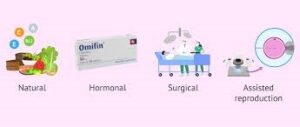Identifying and Addressing Male Infertility

Male infertility is a complex issue that affects many couples trying to conceive. To address this condition, accurate diagnosis and effective treatment options are essential. This article discusses the diagnostic procedures used to identify infertility in men, including semen analysis and physical examinations, as well as various treatment options available, such as medication, surgery, and assisted reproductive technologies (ART) like in vitro fertilization (IVF) and intrauterine insemination (IUI).
Diagnostic Procedures for Male Infertility

Accurate diagnosis is the first step in managing male infertility. A comprehensive evaluation typically includes a detailed medical history, physical examination, and specific laboratory tests.
1. Medical History and Physical Examination as a male infertility diagnosis
The evaluation process begins with a thorough medical history and physical examination. Healthcare providers will assess:
- Medical History: Questions about previous medical conditions, surgeries, medications, lifestyle habits (such as smoking and alcohol use), and any history of testicular or genital infections.
- Family History: Genetic factors may contribute to infertility, so family history of infertility or genetic disorders is important to note.
- Physical Examination: A physical exam of the reproductive organs can help identify any abnormalities, such as varicocele (enlarged veins in the scrotum), hernias, or signs of hormonal imbalances.
2. Semen Analysis as a male infertility diagnosis
Semen analysis is the cornerstone of male infertility diagnosis. This test evaluates several parameters of the sperm, including:
- Sperm Count: The total number of sperm present in a given volume of semen. A count below 15 million sperm per milliliter is considered low (oligospermia).
- Motility: The percentage of sperm that can move actively. Normal motility is at least 40%.
- Morphology: The shape and structure of sperm. Abnormal morphology can affect the sperm’s ability to fertilize an egg.
- Volume: The total volume of semen produced during ejaculation, which should be at least 1.5 milliliters.
- pH Level: Semen should typically have a pH between 7.2 and 8.0.
A semen analysis is usually performed after a period of abstinence (2-5 days) to ensure optimal results. If abnormalities are found, repeat testing may be necessary to confirm the findings.
3. Hormonal Testing as a male infertility diagnosis
Hormonal testing may be conducted to evaluate levels of hormones that regulate male fertility, including:
- Testosterone: Low levels can indicate issues with testicular function or pituitary gland disorders.
- Luteinizing Hormone (LH): Essential for testosterone production; abnormal levels may indicate hormonal issues.
- Follicle-Stimulating Hormone (FSH): Important for sperm production; abnormal levels may signal problems with the testes.
4. Genetic Testing as a male infertility diagnosis
If sperm abnormalities are detected, genetic testing may be recommended. Tests can identify:
- Klinefelter Syndrome: Characterized by an extra X chromosome, which can lead to infertility.
- Y Chromosome Microdeletions: Small deletions on the Y chromosome can impact sperm production.
- Cystic Fibrosis Gene Mutations: These mutations can lead to congenital absence of the vas deferens, affecting fertility.
5. Imaging Studies
Imaging studies, such as a scrotal ultrasound, may be used to identify structural abnormalities, such as varicoceles or obstructions in the reproductive tract. Transrectal ultrasound may also be used to examine the prostate and seminal vesicles for abnormalities that could affect fertility.
Treatment Options for Male Infertility

Once a diagnosis has been made, various treatment options are available based on the underlying cause of infertility. Treatment strategies may include medication, surgery, or assisted reproductive technologies (ART).
1. Medication
Medications may be prescribed to address hormonal imbalances or treat specific medical conditions that affect fertility:
- Hormonal Therapy: If low testosterone levels or hormonal imbalances are diagnosed, hormone replacement therapy may be considered to restore normal levels.
- Antibiotics: If infections are detected in the reproductive tract, antibiotics may be prescribed to eliminate the infection.
- Anti-estrogens: In some cases, medications that block estrogen may be used to increase testosterone levels and improve sperm production.
2. Surgery
Surgical intervention may be necessary for certain conditions that contribute to infertility:
- Varicocele Repair: Varicoceles are enlarged veins in the scrotum that can negatively affect sperm production and quality. Surgical correction can improve fertility outcomes.
- Obstruction Surgery: If blockages are identified in the reproductive tract (e.g., vas deferens), surgical procedures can be performed to restore the pathway for sperm transport.
- Testicular Surgery: In cases of testicular torsion or trauma, surgery may be necessary to restore blood flow or correct structural damage.
3. Assisted Reproductive Technologies (ART)
For couples facing infertility, assisted reproductive technologies (ART) offer advanced options to help achieve pregnancy. Two of the most commonly used ART methods are in vitro fertilization (IVF) and intrauterine insemination (IUI).
In Vitro Fertilization (IVF)
IVF involves retrieving eggs from the female partner and fertilizing them with sperm in a laboratory setting. The fertilized eggs (embryos) are then transferred to the woman’s uterus. IVF is typically recommended in cases of:
- Severe male infertility (e.g., very low sperm count or motility issues).
- Genetic disorders that may require preimplantation genetic testing (PGT).
- Unexplained infertility when other treatments have failed.
Intrauterine Insemination (IUI)
IUI involves placing washed and concentrated sperm directly into the uterus during ovulation. This procedure is less invasive and is often used when:
- The male partner has mild sperm abnormalities.
- There are issues with cervical mucus that may hinder sperm passage.
- Couples are experiencing unexplained infertility.
4. Sperm Retrieval Techniques
In cases of azoospermia (no sperm in the ejaculate), sperm retrieval techniques may be employed:
- Testicular Sperm Extraction (TESE): A surgical procedure that involves extracting sperm directly from the testes.
- Percutaneous Epididymal Sperm Aspiration (PESA): A minimally invasive technique to collect sperm from the epididymis.
These retrieved sperm can then be used in conjunction with ART methods like IVF.
Conclusion.
Diagnosing and treating male infertility requires a comprehensive approach that considers medical, hormonal, and lifestyle factors. Accurate diagnosis through semen analysis, hormonal testing, and imaging studies is crucial for identifying the underlying causes of infertility.
Once a diagnosis is established, treatment options range from medications and surgical interventions to advanced assisted reproductive technologies like IVF and IUI. By addressing male infertility proactively and compassionately, couples can enhance their chances of conception and navigate the emotional complexities of infertility together.
References:
- World Health Organization (WHO). (2021). “Infertility.” Retrieved from WHO website.
- American Urological Association. (2018). “Evaluation of the Infertile Male: AUA Guideline.” Retrieved from AUA website.
- Practice Committee of the American Society for Reproductive Medicine. (2015). “Diagnosis and Treatment of Infertility in Men.” Fertility and Sterility, 103(1), e44-e50.
Written by Fawzi Rufai, Medically Reviewed by Sesan Kareem